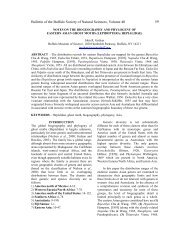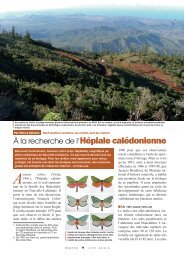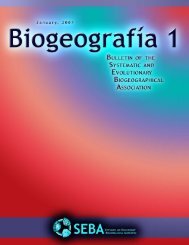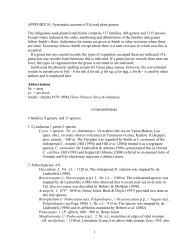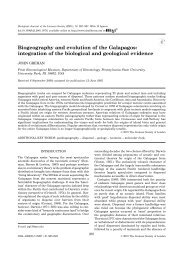Create successful ePaper yourself
Turn your PDF publications into a flip-book with our unique Google optimized e-Paper software.
Dalaca mummia Schaus, 1892<br />
Dalaca mummia Schaus (1892: 330); holotype ♀, Brazil,<br />
[Rio de Ja nei ro], Petrópolis, Schaus leg.; coll. Schaus; [GP<br />
P. Viet te no. 91520, type no. 18606]; USNM. — Bertkau<br />
(1893: 190). — Nielsen & Robinson (1983: 21). — Robinson &<br />
Nielsen (1984: 17). — Nielsen et al. (2000: 844).<br />
Dalaca mummea [sic]: Wagner & Pfitzner (1911: 14). —<br />
Pfitzner (1937: 1295).<br />
Remarks. It is difficult to match the holotype (♀) to any known ♂<br />
and, anyway, placing it into any described genus depends on further<br />
investigation. So, we keep the sys te ma tic position chosen by<br />
Nielsen & Ro bin son (1983).<br />
Dalaca niepelti Pfitzner, 1914<br />
Dalaca niepelti Pfitzner (1914: 59; pl. 11, figs. 14 ♂ dorsal, 15<br />
♀ dorsal); Ecuador, Macas; coll. Niepelt; [BMNH]. — Strand<br />
(1927: 42). — Pfitzner (1937: 1296). — Zukowski (1954: 94). —<br />
Nielsen & Robinson (1983: 21). — Robinson & Niel sen (1984:<br />
17). — Nielsen et al. (2000: 844).<br />
Remarks. It is difficult to match the holotype (♀) to any known ♂<br />
and, anyway, placing it into any described genus depends on further<br />
investigation. So, we keep the sys te ma tic position chosen by<br />
Nielsen & Ro bin son (1983).<br />
Dalaca usaque Pfitzner, 1914<br />
Dalaca usaque Pfitzner (1914: 105); Colombia, Muzo, 700 m,<br />
Fassl [leg.]; coll. Pfitzner; [SMFL]; ◊ (1937: 1294; pl. 99f [♂]<br />
dorsal). — Schröder (1967: 340); “holotype” [recte lectotype:<br />
Pfitzner described the taxon based on an incertain number<br />
of specimens, so a type designation creates a lectotype] ♂,<br />
SMFT 82; East Gramal near Muzo; GP Viette no. 2351. —<br />
Nielsen & Robinson (1983: 21). — Robinson & Nielsen (1984:<br />
17). — Nielsen et al. (2000: 844).<br />
Remarks. The holotype ♂ does not fit into any known genus, so<br />
we prefer to retain the last (pro vi sio n al) systematic position as<br />
de fined by Nielsen & Ro bin son (1983).<br />
Dalaca vibicata Pfitzner, 1914<br />
Dalaca vibicata Pfitzner (1914: 105); [Colombia], Soso mo co,<br />
Fassl [leg.]; coll. Pfitzner; [SMFL]. — Fassl (1918: 19). —<br />
Pfitzner (1937: 1294; pl. 99c [♂] dorsal). — Schröder (1967:<br />
340); “holotype” [recte lectotype, see usaque Pfitz ner, 1914,<br />
similar case] ♂, SMFT 86; iii. 1911; GP Viette no. 2350. —<br />
Nielsen & Robinson (1983: 21). — Robinson & Nielsen (1984:<br />
17). — Nielsen et al. (2000: 844).<br />
Remarks. The holotype ♂ does not fit into any known genus, so<br />
we prefer to retain the last (pro vi sio n al) systematic position as<br />
de fined by Nielsen & Ro bin son (1983).<br />
“Hepialus sp.”<br />
Hepialus sp.: Koebele (1924: 56–59, 68). — Swezey (1925:<br />
376). — Gara & Onore (1989: 142; fig. 115 larva).<br />
Remarks. This reference of an unidentified species in definitively<br />
an incorrect genus exists, so until we know which species the<br />
authors were dealing with, we keep this data here. It cannot, of<br />
course, be included in the checklist.<br />
Phassus costaricensis Druce, 1887<br />
Phassus costaricensis Druce (1887: 234; pl. 24, fig. 4 [♀] dorsal);<br />
single specimen [= holotype], Costa Rica, Van Pat ten<br />
[leg.]; BMNH. — Kirby (1892: 890). — Wagner & Pfitz ner<br />
(1911: 17). — Pfitzner (1938: 1300; pl 185c [♀] dorsal). —<br />
Niel sen & Robinson (1983: 18). — Robinson & Nielsen (1984:<br />
16). — Nielsen et al. (2000: 841).<br />
Dalaca costaricensis: Forbes (1942: 406); as synonym of<br />
Da la ca assa Druce, 1887.<br />
151<br />
Remarks. The holotype was examined, and it was found to lack a<br />
wing pattern similar to that of the type-species of the genus Phassus<br />
Walker, 1856. The holotypes of costaricensis and assa appear<br />
to be different, so Forbes’ (1942) synonymisation requires fur ther<br />
studies. It is difficult to match the holotype of costaricensis (♀) to<br />
any known ♂ and, anyway, placing it into any described ge nus<br />
depends on fur ther investigation. So, we keep the generic as sociation<br />
chosen by Nielsen et al. (2000); the species was moved to<br />
the incertae sedis position by us.<br />
Phassus eldorado Pfitzner, 1906<br />
Pfitzner (1906: 276); single ♂ [= holotype], Venezuela,<br />
Me rí da; coll. Pfitzner; [SMFL]. — Wagner & Pfitzner (1911:<br />
18). — Pfitzner (1938: 1298; pl. 99g [♂] dorsal). — Schrö der<br />
(1967: 342); holotype ♂, SMFT 48; GP Viette no. 2355. —<br />
Nielsen & Robinson (1983: 18). — Robinson & Niel sen (1984:<br />
16). — Nielsen et al. (2000: 841).<br />
Remarks. The holotype was examined, and it was found to lack a<br />
wing pattern similar to that of the type-species of the genus Phassus<br />
Walker, 1856. Placing the taxon into any genus depends on<br />
further investigation, so we keep the generic as so ciation chosen by<br />
Nielsen et al. (2000); the species was moved to the incertae sedis<br />
position by us.<br />
Phassus guianensis Schaus, 1940<br />
Schaus (1940: 83, 88); [holo-]type [♂], British Guiana, Karta<br />
bo; type no. 34749; USNM. — Nielsen & Robinson (1983:<br />
18). — Robinson & Nielsen (1984: 16). — Nielsen et al. (2000:<br />
841).<br />
Remarks. The holotype was examined, and it was found to lack a<br />
wing pattern similar to that of the type-species of the genus Phassus<br />
Walker, 1856. Placing the taxon into any genus depends on<br />
further investigation, so we keep the generic as so ciation chosen by<br />
Nielsen et al. (2000); the species was moved to the incertae sedis<br />
position by us.<br />
Phassus pretiosus (Herrich-Schäffer, [1856])<br />
Epialus [sic] pretiosus Herrich-Schäffer ([1856]: cover;<br />
pl. 88, fig. 505); Brazil; ◊ ([1856]: 5; fig. 505 [♂] dorsal); ◊<br />
([1858]: 57, 84; fig. 505), syn.: plusia Boisduval, in litt.<br />
= Epialus plusia Herrich-Schäffer ([1856]: 57); as syn onym<br />
of Epialus [sic] pretiosus Herrich-Schäffer, [1856]<br />
Hepialus pretiosus: Kirby (1892: 884). — Wagner & Pfitzner<br />
(1911: 9).<br />
Hepialus (Hepialus) pretiosus: Pfitzner (1937: 1291).<br />
Phassus pretiosus: Nielsen & Robinson (1983: 18). — Ro binson<br />
& Nielsen (1984: 16). — Nielsen et al. (2000: 841).<br />
Remarks. The holotype was not not found, but according to Herrich-Schäffer’s<br />
figure, it appears to lack a wing pattern si mi lar<br />
to that of the type-species of the genus Phas sus Walker, 1856.<br />
Placing the taxon into any genus depends on further in ves ti ga tion,<br />
so we keep the generic as so ciation chosen by Nielsen et al. (2000);<br />
the species was moved to the incertae se dis position by us.<br />
Phassus smithi Druce, 1889<br />
Druce (1889: 92); single specimen [= holotype], Mexico, Atoyac,<br />
Vera Cruz, v. 1888, H. H. Smith [leg.]; [BMNH]. — Kir by<br />
(1892: 890). — Druce (1898: 452; pl. 89, fig. 5 [♀] dor sal).<br />
— Wagner & Pfitzner (1911: 18). — Pfitzner (1938: 1300;<br />
pl. 185d [♀] dorsal). — Nielsen & Robinson (1983: 18). —<br />
Robinson & Nielsen (1984: 16). — Nielsen et al. (2000: 841).<br />
Remarks. The holotype was examined, and it was found to lack a<br />
wing pattern similar to that of the type-species of the genus Phassus<br />
Walker, 1856. It is difficult to match the holotype (♀) to any<br />
known ♂ and placing it into any described genus depends on further<br />
investigation. So, we keep the generic as so ciation chosen by





